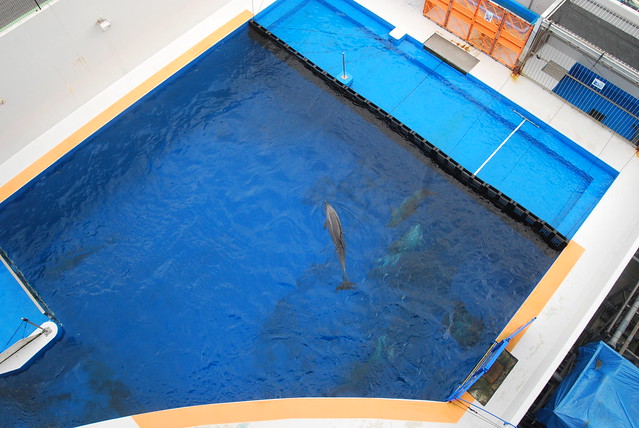This year’s second dolphin drive hunt in Taji, Japan, took place on September 10. It involved the capture of a pod of bottlenose dolphins and the selection of one “show quality” individual who is destined for a life in captivity. It will be trained in one of the cramped sea pens anchored in the Taiji harbour, and then be shipped to one of the growing number of marine parks, aquariums or dolphinariums around the world.
 Photo by Mark J. Palmer Dolphins at an aquarium in Tokyo. Show dolphins’ natural behavior is suppressed and replaced with
Photo by Mark J. Palmer Dolphins at an aquarium in Tokyo. Show dolphins’ natural behavior is suppressed and replaced with
‘tricks’ taught through a brutal training regime involving routine starvation.
Thankfully, the rest of this pod was released back into the wild, unscathed.
While the dolphin slaughters in Taiji are cruel, it is important to understand that the problem does not begin, nor does it end, exclusively within Japan (Read Bridgeman’s earlier report about the first day of the hunt in Taji). People who purchase tickets to captive dolphin shows share a degree of responsibility and, therefore, have an important role to play if abuse towards dolphins is to be stopped for good.
A single live dolphin can be worth in as much as $157,000. This creates a powerful incentive for the dolphin hunters, and the Japanese government, to ensure that hefty hunting quotas continue to be allocated each year, and for the hunts to proceed unhindered. While the actions of these hunters are certainly cruel, they are motivated through trying to provide a living for themselves and their families. They see nothing wrong in what they are doing; many of them were taught as children that dolphins are no different than fish, instead of being the sentient mammals we now know them to be.
Given the economic incentives, particularly from live dolphin exports, it becomes clear why these hunts continue. It is the captivity industry which ultimately fund the hunts by purchasing live dolphins. The industry receives the millions of dollars it requires to purchase, ship, and ‘care for’ these dolphins from none other than the millions of unaware dolphin-lovers who flock to their facilities each year to get a glimpse of these animals as they perform mundane tricks in their small tanks. Thanks to informative documentaries, such as Stan Minasian’s A Fall From Freedom, the dark side of the captivity industry is being brought to the public’s attention.
Aside from the horror of the slaughters, it’s impossible to argue that a life in captivity is fair to cetaceans. Companies that support the captivity industry, including aquariums, dolphinariums, most cruise lines and many hotel chains operating in the US, care only for their bottom lines and will go to great lengths to ensure that these are protected. They claim that there is an educational value in close encounters with captive dolphins. This, however, is totally false. Show dolphins’ natural behavior is suppressed and replaced with human-taught ‘tricks’, such as balancing a ball on their beaks or towing people through the water with their flippers, all of which is reinforced through a brutal training regime involving routine starvation.
To put an end to dolphin slaughter and exploitation at the hands of the Taiji hunters, the Japanese government, and the unethical captivity industry, awareness must be raised around the world. Companies that support or are directly involved in the industry should be boycotted, rather than simply targeting the Japanese in general. This will be far more effective and will halt the undue prejudice towards this nation of otherwise peaceful and respectful people.
Some progress has been made by Earth Island’s International Marine Mammal Project’s (IMMP), which is working at providing alternative employment, such as whale- and dolphin-watching ecotourism and sustainable fishing to supplant the dolphin hunts. Whale meat consumption dropped by 30 percent in Japan last year, likely due to The Cove movie and IMMP’s campaign warning the public about mercury contamination of dolphin and whale meat. (Dolphin meat is often sold falsely labeled as whale meat.) Furthermore, the dolphin killers of Taiji broke off last season a month early due to our presence and the lack of market for dolphin meat.
Ric O’Barry (of IMMP’s Save Japan Dolphins project) recently made a trip to the islands of Miyakejima and Mikurajima, near Tokyo, where islanders have established a successful tourism business based on wild dolphin watching tours. This is one of many examples in Japan which prove that wild and free dolphins can provide the basis of a functional and ethically sound way of making a living.
As I write this, 12 more hunting boats have left the Taiji harbor in search of their next victims. Should the hunters’ quotas be filled, many more dolphins will be condemned to endure a life spent in small tanks, permanently separated from their families and their home.
People who love dolphins surely would not condemn them to this fate. Let us start treating them with the respect they deserve. Find out more about what you can do to help.
Laura Bridgeman has long been interested in environmental issues. (They called her the “nature freak” in high school.) After graduating from university in Canada, she came to work with the Earth Island Institute to follow her passion. She works closely with Ric O’Barry’s Save Japan Dolphins project and is also involved in fostering youth leadership with the Institute’s New Leaders Initiative .
We don’t have a paywall because, as a nonprofit publication, our mission is to inform, educate and inspire action to protect our living world. Which is why we rely on readers like you for support. If you believe in the work we do, please consider making a tax-deductible year-end donation to our Green Journalism Fund.
Donate